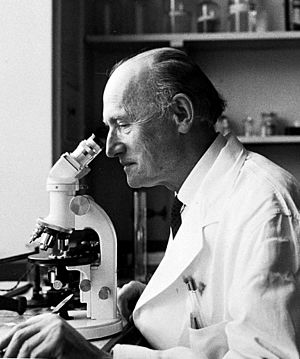Cyril Garnham facts for kids
Percy Cyril Claude Garnham (born January 15, 1901 – died December 25, 1994) was a British biologist and parasitologist. A parasitologist is a scientist who studies parasites. He was known for his important work on malaria. On his 90th birthday, people called him the "greatest living parasitologist." This shows how much his work was respected.
Contents
Early Life and Education
Cyril Garnham was born in London, England. His father, Percy Claude Garnham, was in the Royal Navy. Sadly, his father died in 1915 during World War I. Cyril's mother, Edith, was a very talented violinist.
Cyril went to Paradise School and later studied medicine at St Bartholomew's Hospital in London. He finished his medical degree in 1925. He also earned a special diploma in public health. In 1928, he received an MD degree from the University of London. He earned this for his research on malaria in Kenya and was even awarded a Gold Medal for his excellent work.
Career in Tropical Medicine
Garnham's career began in 1925. He joined the British Colonial Medical Service in Kenya, Africa. This job allowed him to study many different tropical diseases. He learned about diseases affecting both humans and animals. He also studied the vectors that spread these diseases, like mosquitoes. His work involved identifying these diseases and finding ways to control them.
Working in Kenya, he met many experts from around the world. One important person was Alwen M. Evans, who was an expert on mosquitoes. They worked together to map where certain types of mosquitoes, like the Anopheles funestus group, lived near Kisumu and the coast. Soon, Garnham started to focus most of his research on malaria. He became the Malaria Research Officer. Later, he became the Director of a new group called the Division of Insect Borne Diseases in Nairobi.
Discovering Malaria's Life Cycle
In 1947, Garnham moved back to London. He became a Reader at the London School of Hygiene and Tropical Medicine. The next year, he made a huge discovery with another scientist named Henry Edward Shortt. They found a special stage of the malaria parasite inside the liver. This was where the parasite changed from one form (called a sporozoite) to another (called a merozoite).
Malaria parasites have a very complex life cycle. They change their shape and form to survive best inside different parts of animals or humans. Understanding this liver stage was a major step in fighting malaria.
In 1952, Garnham became a professor of Protozoology. Protozoology is the study of tiny, single-celled organisms like the malaria parasite. He later became the head of the Parasitology Department. He guided many students from different countries who were working on their doctoral degrees.
His book, Malaria Parasites and other Haemosporidia (published in 1966), was a detailed look at malaria parasites. It also covered their relatives found in humans, animals, and birds. The book focused on what these parasites looked like and how they were structured. It brought together a lot of information in an organized way.
Later Research and Retirement
Cyril Garnham officially retired in 1968. However, he continued to work for another 12 years! He was a senior research fellow at Imperial College. During this time, he even organized an expedition in 1972 to Borneo. The goal was to find a specific malaria parasite called Plasmodium pitheci again. On this trip, they also discovered a brand new species, Plasmodium silvaticum. He finally retired for good in 1979.
Awards and Recognition
Cyril Garnham received many awards for his important scientific work.
- In March 1964, he was chosen as a Fellow of the Royal Society. This is a very high honor for scientists in the United Kingdom.
- He was also made a Companion of the Most Distinguished Order of St Michael and St George. This is another important award from the British government.
- In 1965, he received the Manson Medal. This is the highest award given by the Royal Society of Tropical Medicine and Hygiene. It is named after Sir Patrick Manson, who was a pioneer in tropical medicine. This medal is given out every three years.
- A total of 21 different parasites and disease-carrying insects (vectors) have been named after him. This shows how much he contributed to the field!
Personal Life
In 1924, Cyril Garnham married Esther Long Price. They had a large family with two sons and four daughters. Outside of his scientific work, he loved playing the piano. He even had a baby grand piano with him when he lived in Kenya! In his retirement, he spent time writing a biography about the famous writer Edgar Allan Poe. He worked on this project until shortly before he passed away on December 25, 1994.
Legacy
Cyril Garnham's scientific papers and notes are kept safe in the archives of the London School of Hygiene and Tropical Medicine. He also collected over a thousand specimens of malaria parasites. These include some very important "type specimens," which are examples used to define a species. This amazing collection is now kept at the Natural History Museum, London. His work continues to help scientists understand and fight malaria today.


